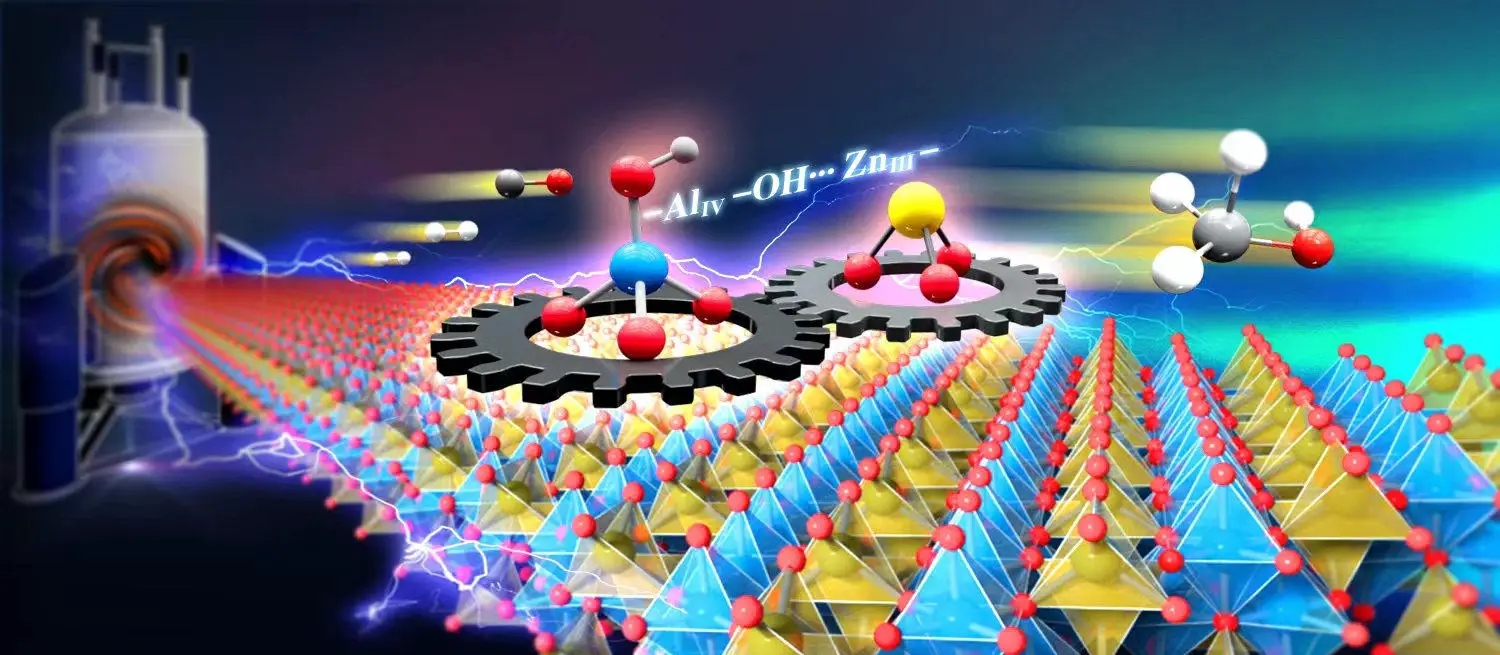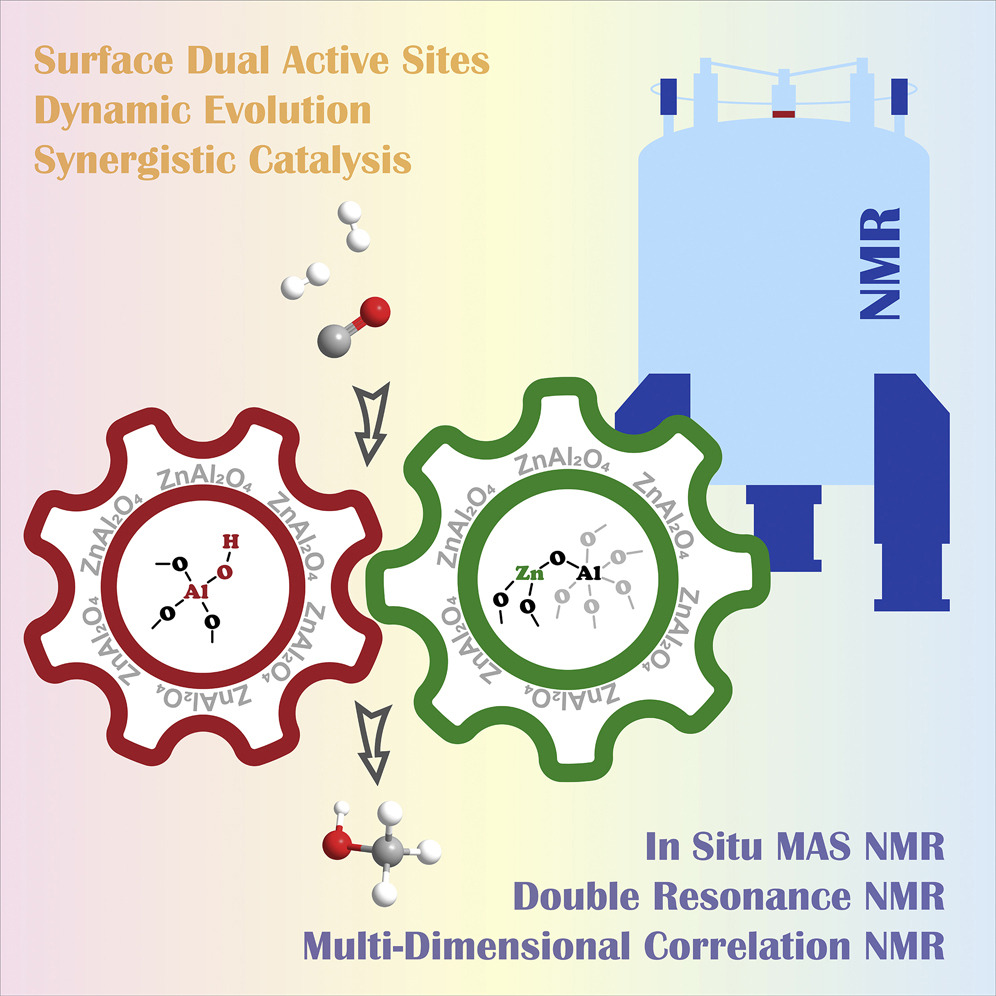博文
大连化物所研究人员揭开合成气催化转化新平台
||
大连化物所研究人员揭开合成气催化转化新平台
诸平

据《科技日报》(SciTechDaily)网站2023年3月9日报道,研究人员揭开合成气催化转化新平台(Researchers Unveil New Platform for Catalytic Syngas Conversion)。
中国科学院大连化学物理研究所(Dalian Institute of Chemical Physics简称DICP, Chinese Academy Of Sciences简称CAS)的研究人员,通过最先进的固态核磁共振技术(solid-state NMR technologies)揭示了用于合成气转换的尖晶石相ZnAl2O4双金属氧化物上双活性位点的协同相互作用(见上图)。
为了弥合不同碳资源和重要化学品之间的差距,催化合成气(catalytic syngas)转化是关键途径。氧化物-沸石(oxide-zeolite简称OXZEO)双功能催化(bifunctional catalysis)是实现这种转化的新平台。
由中国科学院(CAS)大连化学物理研究所(DICP)催化基础国家重点实验室侯广进(Hou Guangjin)教授领导的研究团队,最近发现了双金属氧化物双活性中心的协同作用机制。这一发现可以提高合成气原子级的转化效率。相关研究结果于2023年2月8日已经在《化学》(Chem)杂志网站发表——Qiao Han, Pan Gao, Kuizhi Chen, Lixin Liang, Zhenchao Zhao, Xinlong Yao, Dong Xiao, Xiuwen Han, Guangjin Hou. Synergistic interplay of dual active sites on spinel ZnAl2O4 for syngas conversion. Chem, Online: 8 February 2023, 9(3): 721-738. DOI: 10.1016/j.chempr.2023.01.004. Print: 9 March 2023. https://doi.org/10.1016/j.chempr.2023.01.004
研究人员结合先进的固态核磁共振(NMR)技术,研究了典型的尖晶石相ZnAl2O4氧化物的合成气转化情况。他们利用原位NMR方法观察了合成气在ZnAl2O4催化剂上转化为甲醇(methanol)的全过程,其中甲酸盐(formate)和甲氧基物种(methoxy species)被确定为关键中间体。
通过一系列双共振和多维相关核磁共振实验,他们确定了具有—AlIV—OH···ZnIII—结构的双活性位点。因此,他们提出了ZnAl2O4催化剂上的双活性中心协同催化合成气转化反应的机理。
此外,他们还详细阐述了在原子水平上反应过程中反应中间体和活性位点的动态演化。
“一方面,我们的工作证明了固态NMR光谱学在研究表面/界面催化方面的能力不断提高。”侯广进说,“另一方面,目前对双金属氧化物催化剂活性中心和反应机理的认识,也为研究其他双金属氧化物体系的合成气转化和CO2加氢提供了启发,为高效氧化物催化剂的合理设计和调节提供了重要的指导。”
本项研究工作得到了中国国家重点研发计划、中国国家自然科学基金、中国辽宁省兴辽英才计划、中国国家博士后创新人才支持计划、中国博士后科学基金、中国科学院大连化学物理研究所创新基金等项目的资助。
上述介绍,仅供参考。欲了解更多信息,敬请注意浏览原文或者相关报道。
• Specific surface dual active sites on ZnAl2O4 for syngas conversion are identified
• Dynamic interaction between the active sites and intermediates is elaborated
• Synergistic interplay of heteroatoms for syngas conversion is revealed
The catalytic syngas conversion is the key route to bridge the gap between various carbon resources and the essential chemicals. Recently, the oxide-zeolite (OXZEO) bifunctional catalysis has emerged as a new platform for this conversion, showing a great potential for further industrialization. However, to become a strong competitor to the conventional Fischer-Tropsch synthesis (FTS), a breakthrough in syngas conversion of OXZEO catalysis is highly demanded, which relies on the in-depth understanding of the structure-activity relationship of the catalysts/reaction, especially on oxide component. Here, we unambiguously identified the specific surface dual active sites on the bimetallic oxide catalyst, and their dynamic evolution with the reactants/intermediates in the syngas activation and conversion, using advanced solid-state NMR techniques. The detailed synergistic effect of heteroatoms for syngas conversion was revealed for the first time at atomic level, which will significantly benefit further rational design of high-efficiency catalysts.
The urgent need for efficiency improvement in the oxide-zeolite bifunctional syngas-to-hydrocarbon catalysis necessitates in-depth mechanistic insights into this reaction, especially for the initial syngas conversion over the oxide component, which remains poor. Herein, we comprehensively investigated syngas conversion over a representative ZnAl2O4 spinel oxide with state-of-the-art solid-state NMR technologies. Notably, specific surface dual active sites for syngas activation with —AlIV—OH···ZnIII— structure were unambiguously identified. More importantly, the dynamic evolution of the reaction intermediates and active sites during the reaction process was elaborated at atomic level by a series of double resonance and multi-dimensional correlation NMR experiments. In combination with in situ spectroscopic characterizations, we revealed the full cycle of the formate-methoxy-based pathway for the syngas-to-methanol conversion via synergistic interplay of the dual active sites. The in-depth atomic-level understanding of the catalytic mechanism will be beneficial to further rational design of high-performance catalysts for syngas conversion.

https://blog.sciencenet.cn/blog-212210-1379873.html
上一篇:拥有皮秒级快门的新型相机,可以看透原子的动态无序状态
下一篇:《自然》:在低温和低压条件下制造出的切实可行的超导材料